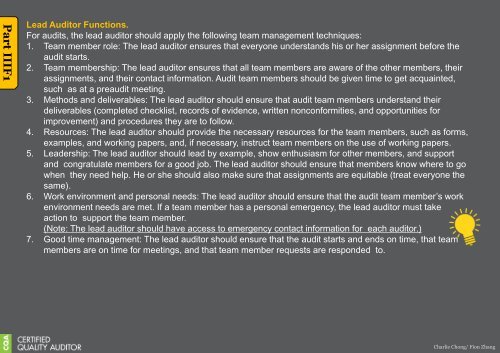My Reading on ASQ CQA HB Part III
You also want an ePaper? Increase the reach of your titles
YUMPU automatically turns print PDFs into web optimized ePapers that Google loves.
<strong>Part</strong> <strong>III</strong>D<br />
ensure the message is clear, the auditor should:<br />
• Use appropriate terminology and avoid terms that are hard to understand<br />
• Avoid lengthy explanati<strong>on</strong>s that dilute the point of the message<br />
• Ensure the accuracy of the informati<strong>on</strong><br />
• Adapt the level and approach of the communicati<strong>on</strong>s to the audience (for example, the CEO, technicians, or<br />
engineers)<br />
To verify that the message is received and understood, the auditor should:<br />
• Verify that the auditee received all messages sent (for example, via teleph<strong>on</strong>e, fax, or e-mail)<br />
• Look for signs of understanding, such as nods of the head and expressi<strong>on</strong>s like “I see”<br />
• Seek feedback by asking clarifying questi<strong>on</strong>s and listening to the resp<strong>on</strong>ses<br />
• Determine when a written record of the communicati<strong>on</strong> is needed<br />
To determine the appropriate medium for transmittal, the auditor should:<br />
• Take into account the formality of the message<br />
• Determine the technology in use by the receiver<br />
• Use the appropriate format for transmissi<strong>on</strong> (for example, letter, memo, e-mail, or ph<strong>on</strong>e)<br />
Charlie Ch<strong>on</strong>g/ Fi<strong>on</strong> Zhang

















